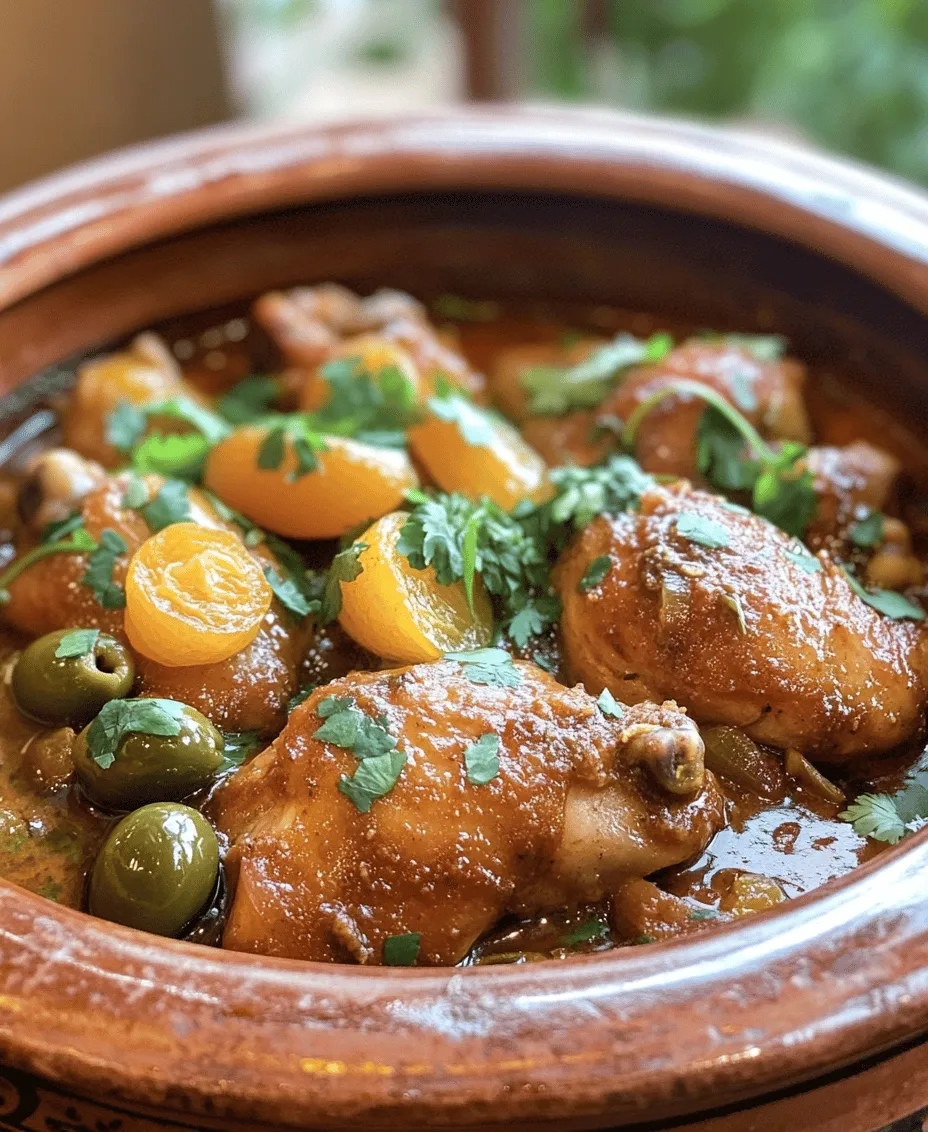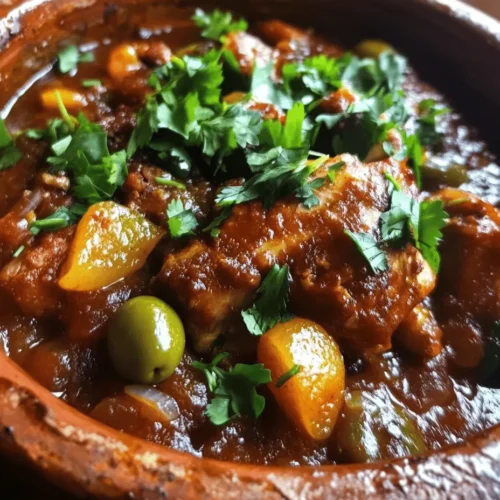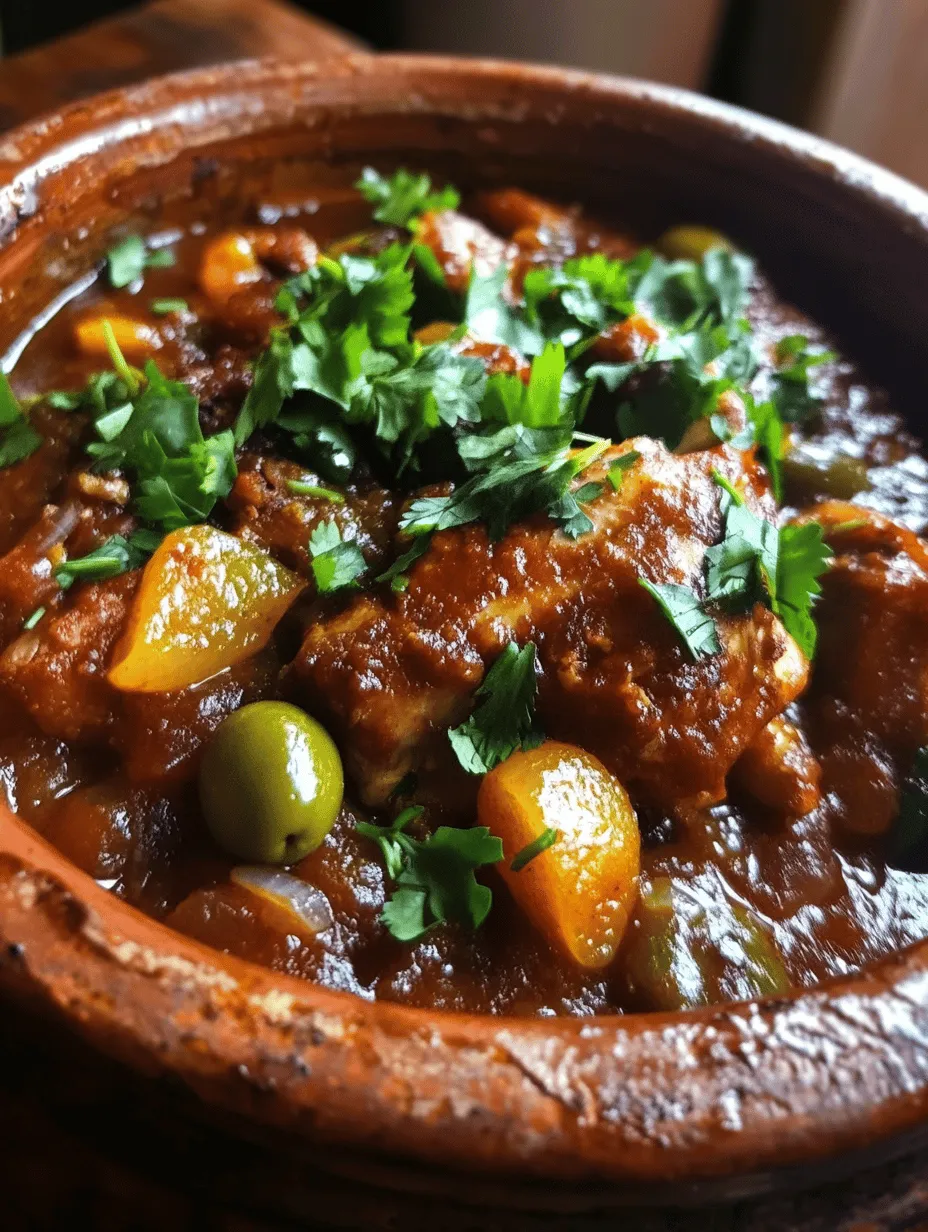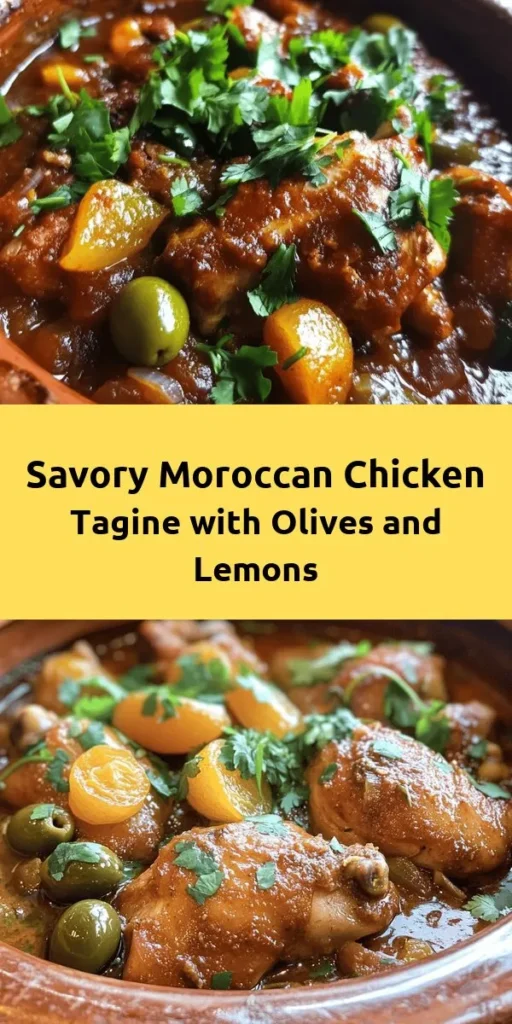Introduction to Moroccan Bliss: Chicken Tagine with Olives & Lemons
Moroccan cuisine is a vibrant tapestry woven from centuries of diverse cultural influences, including Berber, Arab, and Mediterranean traditions. Renowned for its aromatic spices, fresh ingredients, and intricate flavor combinations, Moroccan food offers a culinary experience that is both delightful and deeply satisfying. Among the many dishes that represent this rich heritage, Chicken Tagine with Olives and Lemons stands out as a beloved staple, celebrated for its unique flavor profile and cultural significance.
The term “tagine” refers not only to the dish itself but also to the traditional earthenware pot used for cooking it. The slow-cooking method employed in a tagine allows the ingredients to meld beautifully, creating a dish that is tender, juicy, and bursting with flavor. Chicken Tagine is particularly cherished in Moroccan households, often prepared for special gatherings and festive occasions. The combination of succulent chicken, briny olives, and tangy preserved lemons creates a harmonious balance that is both savory and refreshing, making it an unforgettable dish.
At the heart of this recipe are several key ingredients that contribute to its aromatic and savory characteristics. Bone-in, skin-on chicken thighs provide rich flavor and moisture, while high-quality olive oil serves as the foundation for sautéing and flavor layering. Aromatics such as onion, garlic, and ginger are essential for building depth, enhanced by a blend of spices including cumin, coriander, cinnamon, and turmeric. The addition of olives and preserved lemons introduces an authentic Moroccan flair, while dried apricots add a touch of sweetness that balances the dish perfectly. Finally, a sprinkle of fresh herbs offers a bright finish, elevating the overall flavor profile.
This article will take you through the step-by-step preparation of Moroccan Chicken Tagine with Olives and Lemons, guiding you through each stage of the cooking process while providing tips and insights that ensure success in your own kitchen.
Understanding the Ingredients in Chicken Tagine
Before diving into the preparation, it’s essential to understand the role each ingredient plays in this exquisite dish. The following sections will provide detailed descriptions of the main components that make up Moroccan Chicken Tagine, ensuring that you appreciate their significance in both flavor and cultural context.
Chicken Thighs
Using bone-in, skin-on chicken thighs is crucial for the success of this recipe. The bone not only adds flavor but also helps retain moisture during the cooking process, resulting in tender, juicy chicken. The skin provides a rich layer of fat that enhances the overall taste and texture of the dish. While you could use boneless, skinless chicken, the traditional method calls for thighs, as they are more forgiving and less likely to dry out during the long, slow cooking process.
Olive Oil
In Moroccan cooking, high-quality olive oil is a staple ingredient that serves multiple purposes. It is used for sautéing aromatics, drizzling over dishes, and even as a finishing touch. The rich, fruity flavor of good olive oil enhances the overall taste of the tagine, making it a vital component. When selecting olive oil for your tagine, look for extra virgin varieties that are cold-pressed for the best flavor.
Aromatics
Aromatics are the backbone of flavor in Moroccan Chicken Tagine. Onions, garlic, and ginger are sautéed together to create a fragrant base that infuses the chicken and other ingredients with depth.
– Onions: When cooked slowly, onions caramelize and develop a natural sweetness that forms the foundation of the dish’s flavor.
– Garlic: Adds a pungent, savory note that complements the other ingredients.
– Ginger: Provides a warm, spicy kick that brightens the overall flavor profile.
Spices
The spice blend used in Chicken Tagine is what truly sets it apart. The following spices contribute to the dish’s complexity and warmth:
– Cumin: Earthy and slightly nutty, cumin is a key spice in Moroccan cuisine and adds depth to the tagine.
– Coriander: With its citrusy undertones, coriander balances the warmth of cumin and enhances the overall flavor.
– Cinnamon: Often associated with sweet dishes, cinnamon adds warmth and a hint of sweetness that beautifully contrasts the savory elements.
– Turmeric: Known for its vibrant color and health benefits, turmeric contributes an earthy flavor and a golden hue to the dish.
Olives and Preserved Lemons
Olives and preserved lemons are quintessential ingredients in Moroccan cooking. They introduce unique flavors that are both savory and tangy:
– Olives: Often brined, olives add a salty, umami-rich element that complements the chicken and spices. Green olives are commonly used in this tagine for their vibrant flavor.
– Preserved Lemons: A staple in Moroccan kitchens, preserved lemons are made by fermenting lemons in salt. The result is a tender, tangy ingredient that brightens the dish and adds complexity. The rind is used in cooking, imparting a distinct citrus flavor that elevates the tagine.
Dried Apricots
Dried apricots are a delightful addition to Chicken Tagine, providing a touch of sweetness that balances the savory elements. Their chewy texture contrasts nicely with the tender chicken and enhances the overall flavor. The natural sugars in the apricots caramelize during cooking, creating a rich, syrupy component that melds beautifully with the other ingredients.
Fresh Herbs
Finally, fresh herbs are the finishing touch that ties the dish together. Chopped cilantro and parsley are commonly used in Moroccan cooking, adding a pop of color and a burst of freshness. Sprinkling these herbs over the finished tagine brightens the dish and enhances its aromatic qualities.
Step-by-Step Preparation of Moroccan Chicken Tagine
Now that we have a clear understanding of the ingredients, let’s dive into the preparation of Moroccan Chicken Tagine with Olives and Lemons. This section will guide you through the essential steps, ensuring that you develop rich flavors and achieve the perfect balance in your dish.
Searing the Chicken
The first step in preparing Chicken Tagine is to sear the chicken. This process is crucial for flavor development, as browning the chicken creates a rich, caramelized exterior that enhances the dish’s overall taste.
1. Heat Your Pan: Start by heating a generous amount of olive oil in your tagine or a heavy-bottomed pot over medium-high heat. The oil should shimmer but not smoke.
2. Add the Chicken: Once the oil is hot, carefully add the chicken thighs, skin-side down. Be sure not to overcrowd the pan, as this will cause the chicken to steam rather than brown. If necessary, work in batches.
3. Achieve the Perfect Sear: Allow the chicken to sear without moving it for about 5-7 minutes, or until the skin is golden brown and crispy. Use tongs to flip the chicken and sear the other side for an additional 5 minutes.
4. Remove and Set Aside: Once the chicken is beautifully browned, remove it from the pan and set it aside. This step is essential, as the rendered fat from the chicken will add flavor to the following ingredients.
Sautéing the Aromatics
With the chicken seared, it’s time to sauté the aromatics. This step builds the flavor foundation for your tagine.
1. Add Onions: In the same pan, add more olive oil if necessary, and then add the chopped onions. Sauté over medium heat, stirring occasionally, until the onions are soft and translucent, about 5-7 minutes. You want them to develop a slight caramelization for optimum sweetness.
2. Incorporate Garlic and Ginger: Once the onions are softened, add minced garlic and grated ginger to the pan. Stir continuously for about 1-2 minutes until fragrant. Be careful not to let the garlic burn, as it can impart a bitter taste to the dish.
Toasting the Spices
Toasting spices is a crucial step that enhances their flavor and aroma.
1. Add the Spice Blend: Sprinkle the cumin, coriander, cinnamon, and turmeric into the pan with the sautéed aromatics. Stir the spices in for about 1-2 minutes, allowing them to toast and release their essential oils. You will know they are ready when they become fragrant and aromatic.
Building the Tagine
Now that your aromatics and spices are ready, it’s time to build your tagine.
1. Return the Chicken: Place the seared chicken back into the pot, nestling it among the sautéed aromatics.
2. Add Liquid: Pour in enough chicken broth or water to cover the chicken halfway. This liquid will help to create a flavorful braising environment.
3. Incorporate Olives and Preserved Lemons: Add the olives and chopped preserved lemons to the pot, distributing them evenly among the chicken.
4. Add Dried Apricots: For a hint of sweetness, toss in the chopped dried apricots at this stage.
5. Bring to a Simmer: Bring the mixture to a gentle simmer, ensuring that the flavors meld together beautifully.
This step-by-step preparation of Moroccan Chicken Tagine with Olives and Lemons sets the foundation for a dish that is both rich in flavor and deeply satisfying. By carefully searing the chicken, sautéing the aromatics, toasting the spices, and layering the ingredients, you create a harmonious blend of tastes that celebrates the essence of Moroccan cuisine.
In the next section, we will explore additional tips for achieving the best results with your tagine, ensuring that every bite is a delightful experience.

The Role of Chicken Broth in Creating a Rich Sauce
In Moroccan Chicken Tagine with Olives and Lemons, chicken broth is not merely an ingredient; it is the backbone of the dish, contributing to its rich, complex sauce. The broth enhances the flavor profile, allowing the spices and aromatics to meld beautifully during the slow cooking process. Using a high-quality chicken broth, preferably homemade or low-sodium, will yield the best results as it infuses the chicken with moisture and flavor while preventing the dish from becoming overly salty.
When simmered slowly, the chicken broth becomes a savory base, absorbing the essence of the spices like cumin, coriander, and turmeric, which are integral to Moroccan cuisine. The result is a luscious sauce that clings to the chicken and vegetables, creating a dining experience that is as satisfying as it is flavorful.
Slow Cooking for Flavor Development
Importance of Low and Slow Cooking for Tender, Flavorful Chicken
Slow cooking is a hallmark of Moroccan tagines, and for good reason. The method allows the chicken to cook evenly, becoming incredibly tender as it absorbs the aromatic flavors of the spices and broth. Cooking the chicken at a low temperature ensures that it remains juicy and succulent, rather than tough or dry.
For this recipe, you can use either a traditional tagine or a heavy-bottomed pot. If you’re using a tagine, it is essential to keep the heat low and to monitor the cooking closely, as the shape of the tagine concentrates heat, which can lead to quicker cooking than expected.
How to Monitor Cooking to Prevent Drying Out
To ensure your chicken doesn’t dry out during the cooking process, check periodically to see if there is enough liquid in the pot. If the sauce is reducing too quickly, you can add more chicken broth or water. A well-cooked tagine should have a rich sauce that envelops the chicken. Keep the lid on as much as possible to maintain moisture and heat, and only remove it to check the progress.
Finishing Touch with Fresh Herbs
The Impact of Fresh Herbs on the Final Flavor Profile
As you approach the end of the cooking process, the addition of fresh herbs elevates the dish to a new level of freshness and vibrancy. Fresh cilantro and parsley are commonly used in Moroccan cuisine and provide a contrast to the deep, warm flavors of the spices. The bright notes from the herbs not only enhance the flavor but also add a burst of color to the dish.
Best Practices for Incorporating Herbs at the End of Cooking
To best incorporate fresh herbs, chop them roughly and add them just a few minutes before you remove the tagine from the heat. This technique allows the herbs to release their essential oils without losing their vibrant green color and fresh flavor. Stir them in gently to coat the chicken and vegetables, ensuring every bite is infused with the aromatic freshness of the herbs.
Serving Suggestions for Moroccan Chicken Tagine
Traditional Accompaniments
Moroccan Chicken Tagine is best enjoyed with traditional sides that complement its rich flavors. Here are a couple of classic accompaniments:
Fluffy Couscous: Preparing couscous is simple and quick. To make fluffy couscous, bring water to a boil (use a ratio of 1 part couscous to 1.5 parts water). Add a pinch of salt, then stir in the couscous, cover, and remove from heat. Let it sit for 5-10 minutes, then fluff with a fork. The couscous will soak up the delicious sauce from the tagine, making each bite a delightful experience.
Crusty Bread: For those who prefer bread, serving Moroccan tagine with crusty bread is an excellent choice. Traditional Moroccan bread, like khobz, is perfect for tearing and soaking up the sauce. Alternatively, a good sourdough or baguette can also work well.
Presentation Tips
To serve the tagine authentically, consider using a traditional tagine pot as your serving dish. This not only adds to the aesthetic but also keeps the dish warm. When plating, arrange the chicken pieces attractively, spoon the sauce over them, and scatter preserved lemon slices and olives for an appealing presentation.
For garnishing, a sprinkle of freshly chopped herbs adds color and freshness. You can also add a few whole olives or lemon wedges around the dish for a vibrant touch.
Nutritional Aspects of Chicken Tagine with Olives & Lemons
Overview of the Nutritional Benefits of Main Ingredients
Moroccan Chicken Tagine is not only a feast for the senses but also offers several nutritional benefits:
– Chicken as a Source of Protein: Chicken is an excellent source of lean protein, essential for building and repairing tissues. It also provides B vitamins, which are crucial for energy metabolism.
– Health Benefits of Olives and Preserved Lemons: Olives are rich in healthy fats, particularly monounsaturated fats, which are beneficial for heart health. They also contain antioxidants that help combat oxidative stress. Preserved lemons add a unique flavor while providing vitamin C and aiding in digestion.
– The Role of Spices in Health and Wellness: The spices used in this dish, such as turmeric and cumin, have anti-inflammatory properties and may contribute to a healthy immune system. Turmeric, in particular, is known for its active compound, curcumin, which has been linked to various health benefits.
Discussing Potential Dietary Modifications
If you’re looking to adapt this recipe to suit specific dietary needs, here are some options:
– Gluten-Free or Low-Carb: For a gluten-free version, serve the tagine with quinoa or cauliflower rice instead of couscous. This allows you to maintain the dish’s flavors while adhering to gluten-free requirements.
– Vegetarian Adaptations: To create a vegetarian version of this dish, you can replace the chicken with hearty vegetables like eggplant, zucchini, and chickpeas. Cook them in the same way, allowing the flavors to develop fully for a satisfying meatless meal.
Conclusion: Embracing Moroccan Cuisine at Home
Moroccan Chicken Tagine with Olives and Lemons embodies the vibrant flavors and rich cultural heritage of Moroccan cuisine. With its combination of spices, fresh ingredients, and slow-cooked perfection, this dish is not only a culinary delight but also an invitation to gather around the table and share a meal with loved ones.
As you explore this recipe, don’t hesitate to experiment with the spices and accompaniments to make it your own. The joy of cooking lies in the ability to adapt and create dishes that resonate with your taste preferences. So, roll up your sleeves, embrace the flavors of Morocco, and enjoy the warmth and connection that comes from cooking and sharing a delicious meal.



